

This section describes ShapeShifters window gadgets one by one in their function. You should use this reference for consultation if you want to learn more about the function of a single setting. How the settings interact and how to configure ShapeShifter for certain things is covered in "Using ShapeShifter":
VOLUMES - MEMORY
SCSI - SERIAL
NETWORK - MISCELLANEOUS
  The Main Settings Window (Click!) |
The "main window" appears directly after starting ShapeShifter:
By selecting one of the eight big gadgets Graphics, Volumes/Disks, Floppys, Memory, SCSI, Serial, Network and Miscellaneous you can open the windows in which you do the settings. A click on "Start" closes the settings windows of ShapeShifter and starts the Macintosh emulation. With "Save", your settings are saved in the file "ShapeShifter Prefs", so they are available at the next start of ShapeShifter. By selecting "Exit" you can quit ShapeShifter while discarding any unsaved settings. ShapeShifter has only one menu, "Project", that offers three items:
"About ShapeShifter..." displays some information about the version of ShapeShifter used and the author of the program. "Save settings" (shortcut Amiga-S) does the same as the gadget "Save". The settings are saved in the file "ShapeShifter Prefs". With "Quit" (shortcut Amiga-Q), you quit ShapeShifter without saving the settings.
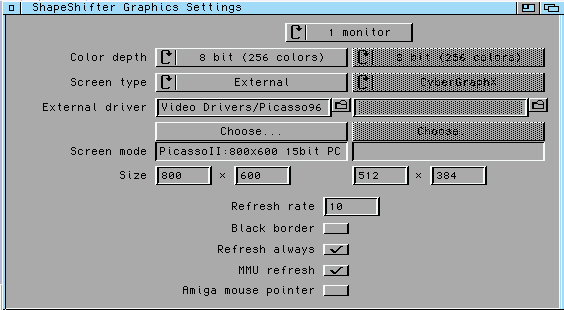 The Graphics Settings Window (Click!) |
Color depth: Here you set the number of colors to be used by the Macintosh. This setting is done here and not in the Monitors control panel, as it gives you the chance to switch to a lower color depth without problems when the speed in higher depth becomes too slow.
Screen type: Here you choose how the screen memory should be handled by ShapeShifter. This setting is closely connected to the selected screen mode. The options are now discussed in detail:
"Amiga bitplanes" is the setting for the normal Amiga graphics modes. You can use 2 to 256 colors. When using more than 2 colors, the graphics have to be refreshed periodically, which has an impact on the speed. Only at 2 colors the graphics is running at full speed.
"CyberGraphX" is for graphics cards with a CyBERgraphics driver. Only color depths of 8, 15 and 24 bit are selectable, while most graphics cards require a refresh at 15 and 24 bit.
"Merlin" must be used for the Merlin graphics card by XPert/ProDev. The only possible color depths are 8, 15 and 24 bit, while 15 and 24 bit require a refresh.
"EGS" If your graphics card works with the "EGS" (Enhanced Graphics System) by Viona Development, you must use this setting. Only color depths of 8, 15 and 24 bit are possible, while 15 and 24 bit require a refresh.
"Picasso" is intended for the Picasso graphics card by Village Tronic. Only color depths of 8, 15 and 24 bit are possible, while 15 and 24 bit require a refresh.
"Amiga window" displays the Macintosh desktop in 2 colors in a window on the Workbench. The Amiga mouse pointer will be used to control symbols and menus of the Macintosh.
Screen mode: After a click on "Choose...", the screen mode requester will open and allow the selection of any Amiga graphics mode to display the Macintosh screen, and the selection of the overscan region to be used. A high resolution, flicker-free mode like "Productivity" or a mode of a graphics card is recommended. For "video applications" you can use the whole available screen for the display. When you have chosen a screen mode, the "Size" gadgets are set automatically to the normal values for this mode.
Size: Here you can manually set the size of the screen in pixels. By entering a smaller size (e.g. 512�384), you can, for instance, increase the speed in higher color depths. For the screen mode "Amiga window", the size of the window is specified here.
Refresh rate: Here you can specify how many 1/50ths of a second should pass between the refreshes. A value of 5 will, for instance, leave a tenth of a second of computing time for the emulator between the refreshes. For the optimal choice of this value, please read the section "Setting the refresh".
Black border: When this gadget is selected, the border around the Macintosh screen is displayed in black (requires ECS/AA), as on the real Macintosh. For graphics cards, this is mostly without effect, they always display a black border.
Always refresh: In the 8 bit graphics card modes, the Macintosh graphics will always go to the front screen of the graphics card, even if it is the Workbench screen, for example. By activating this gadget, a refresh is done also in 8 bit, thereby preventing this annoying effect, but slowing down the graphics speed.
MMU refresh: When this option is enabled, ShapeShifter will try to use to MMU to only refresh the parts of the screen that have changed. This will only work on 68040s with default MMU setup and has no effect on other processors. For the 68060 processor, this option must be turned off.
Amiga mouse pointer: If this box is checked, the Amiga mouse pointer will be used for selecting things on the Macintosh side, too. This is always the case in Amiga Window mode.
 The Volumes/Disks Settings Window (Click!) |
FileDisk 1/2: In these two gadgets, you give the name of the files that ShapeShifter should use for the first resp. the second "FileDisk". Instead of entering the name by hand, you may as well click on the symbol to the right of the text gadgets that will open a file requester. The gadget "Create..." is used to create a new FileDisk file. First, you have to enter the size in KB and, after a click on "Choose file...", set the name of the file in the file requester (you can also select an existing file, it will then be overwritten).
DeviceDisk 1/2: Here you enter the name of the Amiga driver to be used for the first resp. the second "DeviceDisk". For SCSI devices, this is usually the name of the SCSI driver, but you may use any other "trackdisk" compatible driver. With a click on "Choose...", a file requester will appear that allows the selection of an existing volume (e.g. a hard drive partition). ShapeShifter will then check if this volume is suitable as a DeviceDisk and will then enter the name of the driver and all the other data into the gadgets automatically. In the string gadget, you may also directly enter the device name of a Macintosh partition (including ":"). The data will then be inquired at run-time.
Unit: Specifies the number of the driver's unit to be used. For SCSI devices, this is the ID of the SCSI device.
First sector/Number of sectors: These values define the section of the volume that is used by ShapeShifter. This is extremely important if you have created proper partitions for the Amiga operating system and ShapeShifter on a shared hard disk. Should the sector values be wrong, ShapeShifter might overwrite data on Amiga partitions. If you don't know about the logical structure of volumes, you should only create a DeviceDisk by using the "Choose..." symbol and not change the automatically entered sector values afterwards.
Maximum transfer size: Some IDE and older SCSI drivers don't like it when the amount of data transfered in one block exceeds a certain size (e.g. 64KB). In this case, you can set the maximum block size with this setting. The setting corresponds directly to the value "MaxTransfer" in the MountList and the Rigid Disk Block and is set right automatically when using "Choose...". When the hard disk has no limitation for the transfer size, you can set this to "-1" or "0".
Removable: If this box is checked ShapeShifter will recognize media changes on this DeviceDisk (e.g. for SyQuests or CD-ROMs).
Boot from: is used to select the startup volume. "Last selection" leaves the setting as it is (or as it has been set in the "Startup volume" control panel from the Mac), "Any" will make ShapeShifter boot from the first found bootable volume and "FileDisk 1" resp. "DeviceDisk 1" forceit to boot from the first File- /DeviceDisk.
 The Floppy Drives Settings Window (Click!) |
Floppy 1/2: Here you select which Amiga floppy drives are to be used as the first and second Macintosh drives. With a click on "Search", ShapeShifter will automatically detect the first two connected drives.
Inhibit AmigaDOS: If this option is selected, AmigaDOS is inhibited from accessing the corresponding drive as long as the emulation runs. This will speed up the recognition of inserted Macintosh disks.
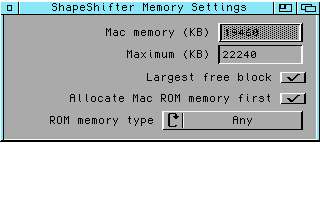 The Memory Settings Window (Click!) |
Mac memory: Here you enter the amount of memory to be reserved for the Macintosh (in KB, 1MB=1024KB). For System 7, this must be at last 1.5MB. ShapeShifter requires additional memory for the ROM and the graphics memory. When you receive the message "There is not enough memory available" on starting the emulation, then please lower the value.
Maximum (KB): The maximum amount of memory available for ShapeShifter is displayed here.
Largest free block: With this setting, ShapeShifter will use the largest available memory block as Macintosh memory. The value entered in "Mac memory", the emulator gets all the memory it can.
Mac ROM in fast memory: When this gadget is checked, ShapeShifter tries to place the Macintosh ROM in the fastest available memory, speeding up the emulation. Otherwise, it could happen that the ROM ends up in Chip RAM or slow 16 bit memory.
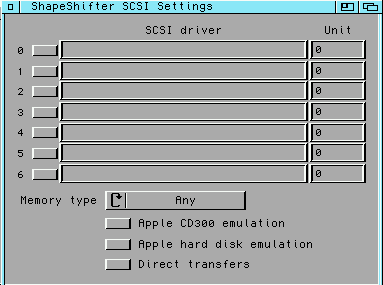 The SCSI Settings Window (Click!) |
SCSI driver: Here your give the name of the "Amiga SCSI driver" that ShapeShifter will use to access the SCSI port. For Amigas with built-in SCSI port or the Commodore SCSI cards, this is "scsi.device". If you use a different SCSI adapter, please consult its documentation about the name of the driver. If the driver is in a file on disk or hard drive, you can select it by clicking on "Choose..." with a file requester.
Unit number of ID 0: This setting gives an additive constant for mapping the SCSI-IDs to the unit numbers of the Amiga SCSI driver. Setting it to "100", for instance, will access the SCSI device with the ID 2 with the driver unit 102. You should only enter a value not equal to "0" if you have installed multiple SCSI adapters in your Amiga, as the hundreds digit of the driver unit is commonly used to select the adapter.
Memory type: Here you set the type of memory to be used for the SCSI transfer buffers. "Chip RAM" will use the Chip RAM, "24 bit DMA" allocates memory in the 24 bit address space (important for DMA Zorro-II cards) and "Any" will get any (but not always the fastest) free memory. Please also read the chapter "Optimizing the speed".
Apple CD300 emulation: When this field is checked, you can use SCSI-2 conforming CD-ROM drives with the "AppleCD" driver. If you have connected a real Apple CD300 or are not using the AppleCD driver but a special one for your drive, you should disable this setting.
Apple hard disk emulation: This setting is only required to make Apple's hard disk installation program believe that an Apple hard drive is connected. Otherwise, it should be left switched off.
0..6: With these checkboxes, individual SCSI IDs can be turned on and off for the Mac.
 The Serial Settings Window (Click!) |
Modem port/Printer port: Here you give the name of the Amiga driver (e.g. "serial.device") to be used for input and output over the Macintosh "modem" resp. "printer" ports. When the driver is on disk, it can be selected with a click on "Choose...".
Device unit: For drivers that support multiple ports of one type, this selects the port. Please consult your I/O cards manual about this. For standard Amigas with one serial and one parallel port, enter "0".
Parallel device: Here you have to specify whether the selected driver is compatible to the "serial.device" or the "parallel.device", i.e. if it drives a serial or a parallel port. A wrong setting may result in malfunctions or even in crashes when accessing the ports.
 The Network Settings Window (Click!) |
Network driver: Here you give the complete path of the SANA-II ethernet driver to be used (e.g. "DEVS:Networks/a2065.device"). Other network hardware like Arcnet is not supported (however, you can run AppleTalk Remote Access or MacTCP with InterSLIP or MacPPP over a serial connection).
Device unit: For drivers supporting multiple cards of one type, you select the card with this setting. Please consult the manual of your Ethernet card about this. Normally, the setting "0" refers to the first/ only card.
 The Miscellaneous Settings Window (Click!) |
Direct mouse polling: With this, you specify whether ShapeShifter should poll the mouse directly by itself or use the Amiga operating system to do this. The direct polling is more compatible to some Macintosh programs. However, you cannot use graphics tablets or touchscreens with it.
Write-protect ROM: When this option is enabled, ShapeShifter will try to write-protect the Macintosh ROM. This will only work on 68040s with default MMU setup and has no effect on other processors. For the 68060 processor, this option must be turned off.
Do not use FPU: With this option, the access to the FPU of the Amiga from the Macintosh can be prevented. For the 68060 processor, this option has to be turned on.
The programs "ShapeShifter", "PrepareEmul", "Mac-Handler","MacControl", "Save ROM" and this manual are � Copyright 1993-1995 Christian Bauer. They may be freely distributed as long as they remain unchanged (archiving and packing are allowed).
Chris J. Schnurr
No profit must be made by distributing ShapeShifter, especially the price of a disk containing ShapeShifter may not exceed US$ 5,- (or equivalent amounts in other currencies). Please feel free to distribute ShapeShifter over bulletin board systems and networks and as part of shareware/freeware CD-ROMs. All rights for commercial use remain with the author.
The keyfile that registered users will receive, must only be installed one one computer and in no case passed on to others. Offences will result in penal prosecution by me. With your signature on the order form, you accept these conditions.
The program is presented to the users as it is, without any warranty of any kind, be it expressed or implicit. Anyone using this program agrees to incur the risk of using it for himself. In no way can the author be made responsible for any damage directly or indirectly caused by the use or misuse of the program.
The Macintosh ROM files necessary for using ShapeShifter are not part of ShapeShifter and are copyrighted by Apple. The author will not take upon himself the responsibility for the legal consequences, an illegal use of such a ROM file can have.
The user interface of the program was designed with GadToolsBox � Copyright 1991-1993 Jaba Development.
Parts of the program are � Copyright 1992-1993 Jaba Development.
"Amiga" and "Commodore" are registered trademarks of Escom AG, Bochum.
"Apple", "Macintosh", "AppleTalk" and "EtherTalk" are registered trademarks of Apple Computer, Inc.
Other mentions:
Names of other hardware and software items mentioned in this manual and in program texts are in most cases registered trade marks of the respective companies and not marked as such. So the lack of such a note may not be used as an indication that these names are free.
EMULATIONWIZARD "THE AUTHOR" No one wanted to develop a software Macintosh emulator. So I had to do it. :-)
Christian Bauer
Langenaustr. 65
56070 Koblenz
Germany
EMail:
bauec002@goofy.zdv.uni-mainz.de
cebix@ng-box.wwbnet.de
WWW:
http://www.uni-mainz.de/~bauec002/
Questions, criticism, suggestions and bug reports are always welcome. EMail is preferred.